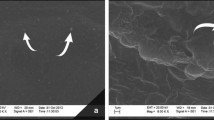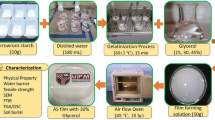Abstract
In this study, sugar palm starch (SPS) films were developed using glycerol (G), sorbitol (S) or their combination (GS) as plasticizers at the ratio of 15, 30 and 45 (wt)% using casting technique. The addition of plasticizers to SPS film-forming solutions helped to overcome the brittle and fragile nature of unplasticized SPS films. Increased plasticizer concentration resulted to an increase in film thickness, moisture content and solubility. On the contrary, density and water absorption of plasticized films decreased with increasing plasticizer concentration. Raising the plasticizer content from 15 to 45 % showed less effect on the moisture content and water absorption of S-plasticized films. Films containing glycerol and glycerol-sorbitol plasticizer (G, and GS) demonstrated higher moisture content, solubility and water absorption capacity compared to S-plasticized films. The results obtained in this study showed that plasticizer type and concentration significantly improves film properties and enhances their suitability for food packaging applications.










Similar content being viewed by others
References
Adawiyah DR, Sasaki T, Kohyama K (2013) Characterization of arenga starch in comparison with sago starch. Carbohydr Polym 92(2):2306–2313
Aguirre A, Borneo R, León AE (2013) Properties of triticale protein films and their relation to plasticizing–antiplasticizing effects of glycerol and sorbitol. Ind Crop Prod 50:297–303
Ahmadi R, Kalbasi-Ashtari A, Oromiehie A, Yarmand MS, Jahandideh F (2012) Development and characterization of a novel biodegradable edible film obtained from psyllium seed (Plantago ovata Forsk). J Food Eng 109(4):745–751
Arvanitoyannis I, Biliaderis CG (1999) Physical properties of polyol/starch edible blends made of methyl cellulose and soluble starch. Carbohydr Polym 38:47–58
BeMiller JN, Whistler RL (2009) Starch: chemistry and technology. Academic Press
Bergo PVA, Carvalho RA, Sobral PJA, Dos Santos RMC, Da Silva FBR, Prison JM, Habitante A (2008) Physical properties of edible films based on cassava starch as affected by the plasticizer concentration. Packag Technol Sci 21(2):85–89
Bodirlau R, Teaca C-A, Spiridon I (2013) Influence of natural fillers on the properties of starch-based biocomposite films. Compos Part B 44(1):575–583
Cerqueira MA, Souza BWS, Teixeira JA, Vicente AA (2012) Effect of glycerol and corn oil on physicochemical properties of polysaccharide films—A comparative study. Food Hydrocoll 27(1):175–184
Chiumarelli M, Hubinger MD (2014) Evaluation of edible films and coatings formulated with cassava starch, glycerol, carnauba wax and stearic acid. Food Hydrocoll 38:20–27
Cuq B, Gontard N, Aymard C, Guilbert S (1997) Relative humidity and temperature effects on mechanical and water vapor barrier properties of myofibrillar protein-based films. Polym Gels Networks 5(1):1–15
Dai H, Yu J, Geng F, Ma X (2009) Preparation and properties of starch-based film using N-(2-hydroxyethyl) formamide as a new plasticizer. Polym-Plast Technol Eng 48(8):866–870
Elberson W, Oyen L (2010) Sugar palm (Arenga pinnata)
Famá L, Rojas AM, Goyanes S, Gerschenson L (2005) Mechanical properties of tapioca-starch edible films containing sorbates. LWT-Food Sci Technol 38(6):631–639
Farris S, Schaich KM, Liu L, Piergiovanni L, Yam KL (2009) Development of polyion-complex hydrogels as an alternative approach for the production of bio-based polymers for food packaging applications: a review. Trends Food Sci Technol 20(8):316–332
García NL, Famá L, Dufresne A, Aranguren M, Goyanes S (2009) A comparison between the physico-chemical properties of tuber and cereal starches. Food Res Int 42(8):976–982
Ghasemlou M, Khodaiyan F, Oromiehie A (2011) Physical, mechanical, barrier, and thermal properties of polyol-plasticized biodegradable edible film made from kefiran. Carbohydr Polym 84(1):477–483
González A, Alvarez Igarzabal CI (2013) Soy protein–Poly (lactic acid) bilayer films as biodegradable material for active food packaging. Food Hydrocoll 33(2):289–296
Gutiérrez TJ, Tapia MS, Pérez E, Famá L (2015) Structural and mechanical properties of edible films made from native and modified cush-cush yam and cassava starch. Food Hydrocoll 45:211–217
Hernández-Munoz P, Kanavouras A, Perry KWN, Gavara R (2003) Development and characterization of biodegradable films made from wheat gluten protein fractions. J Agric Food Chem 51:7647–7654
Hu G, Chen J, Gao J (2009) Preparation and characteristics of oxidized potato starch films. Carbohydr Polym 76(2):291–298
Imran M, El-Fahmy S, Revol-Junelles AM, Desobry S (2010) Cellulose derivative based active coatings: effects of nisin and plasticizer on physico-chemical and antimicrobial properties of hydroxypropyl methylcellulose films. Carbohydr Polym 81(2):219–225
Imre B, Pukánszky B (2015) Compatibilization in bio-based and biodegradable polymer blends. Eur Polym J 49(6):1215–1233
Ishak MR, Sapuan SM, Leman Z, Rahman MZA, Anwar UMK, Siregar JP (2013) Sugar palm (Arenga pinnata): Its fibres, polymers and composites. Carbohydr Polym 91(2):699–710
Jiménez A, Fabra MJ, Talens P, Chiralt A (2012) Edible and biodegradable starch films: a review. Food Bioprocess Technol 5(6):2058–2076
Jouki M, Khazaei N, Ghasemlou M, HadiNezhad M (2013) Effect of glycerol concentration on edible film production from cress seed carbohydrate gum. Carbohydr Polym 96(1):39–46
Kristo E, Biliaderis CG (2006) Water sorption and thermomechanical properties of water/sorbitol-plasticized composite biopolymer films: caseinate-pullulan bilayers and blends. Food Hydrocoll 20(7):1057–1071
Kurt A, Kahyaoglu T (2014) Characterization of a new biodegradable edible film made from salep glucomannan. Carbohydr Polym 104:50–8
Lopez O, Garcia MA, Villar MA, Gentili A, Rodriguez MS, Albertengo L (2014) Thermo-compression of biodegradable thermoplastic corn starch films containing chitin and chitosan. LWT Food Sci Technol 57(1):106–115
Ma X, Yu J (2004) The plastcizers containing amide groups for thermoplastic starch. Carbohydr Polym 57(2):197–203
Maran JP, Sivakumar V, Sridhar R, Thirugnanasambandham K (2013) Development of model for barrier and optical properties of tapioca starch based edible films. Carbohydr Polym 92(2):1335–47
Müller CMO, Yamashita F, Laurindo JB (2008) Evaluation of the effects of glycerol and sorbitol concentration and water activity on the water barrier properties of cassava starch films through a solubility approach. Carbohydr Polym 72(1):82–87
Osés J, Fernández-Pan I, Mendoza M, Maté J (2009) Stability of the mechani-cal properties of edible films based on whey protein isolate during storage atdifferent relative humidity. Food Hydrocoll 23:125–131
Park JW, Im SS, Kim SH, Kim Y (2000) Biodegradable polymer blends of poly(L lactic acid) and gelatinized starch. Polym Eng Sci 40:2539–2550
Peelman N, Ragaert P, De Meulenaer B, Adons D, Peeters R, Cardon L, Van Impe F (2013) Application of bioplastics for food packaging. Trends Food Sci Technol 32(2):128–141
Perez E, Segovia X, Tapia MS, Schroeder M (2012) Native and cross-linked modified Dioscorea trifida (cush-cush yam) starches as bio-matrices for edible films. J Cell Plast 48(6):545–556
Perez‐gago MB, Krochta JM (2001) Denaturation time and temperature effects on solubility, tensile properties, and oxygen permeability of whey protein edible films. J Food Sci 66(5):705–710
Razavi SMA, Mohammad Amini A, Zahedi Y (2015) Characterisation of a new biodegradable edible film based on sage seed gum: Influence of plasticiser type and concentration. Food Hydrocoll 43:290–298
Sahari J, Sapuan SM, Ismarrubie ZN, Rahman MZA (2011) Comparative study of physical properties based on different parts of sugar palm fibre reinforced unsaturated polyester composites. Key Eng Mater 471:455–460
Sahari J, Sapuan SM, Zainudin ES, Maleque MA (2012a). A new approach to use arenga pinnata as sustainable biopolymer : effects of plasticizers on physical properties, 4, 254–259
Sahari J, Sapuan SM, Zainudin ES, Maleque MA (2012b) Sugar palm tree: a versatile plant and novel source for biofibres, biomatrices, and biocomposites. Polym Renewable Resour 3(2):61–77
Sahari J, Sapuan SM, Zainudin ES, Maleque MA (2013) Thermo-mechanical behaviors of thermoplastic starch derived from sugar palm tree (Arenga pinnata). Carbohydr Polym 92(2):1711–1716
Sahari J, Sapuan SM, Zainudin ES, Maleque MA (2014) Physico-chemical and thermal properties of starch derived from sugar palm tree (Arenga pinnata). Asian J Chem 26(4):955–959
Shirai MA, Grossmann MVE, Mali S, Yamashita F, Garcia PS, Müller CMO (2013) Development of biodegradable flexible films of starch and poly (lactic acid) plasticized with adipate or citrate esters. Carbohydr Polym 92(1):19–22
Siracusa V, Rocculi P, Romani S, Rosa MD (2008) Biodegradable polymers for food packaging: a review. Trends Food Sci Technol 19(12):634–643
Suppakul P, Chalernsook B, Ratisuthawat B, Prapasitthi S, Munchukangwan N (2013) Empirical modeling of moisture sorption characteristics and mechanical and barrier properties of cassava flour film and their relation to plasticizing–antiplasticizing effects. LWT-Food Sci Technol 50(1):290–297
Talja RA, Helén H, Roos YH, Jouppila K (2007) Effect of various polyols and polyol contents on physical and mechanical properties of potato starch-based films. Carbohydr Polym 67(3):288–295
Talja RA, Helén H, Roos YH, Jouppila K (2008) Effect of type and content of binary polyol mixtures on physical and mechanical properties of starch-based edible films. Carbohydr Polym 71(2):269–276
Tharanathan RN (2003) Biodegradable films and composite coatings: past, present and future. Trends Food Sci Technol 14(3):71–78
Ticoalu A, Aravinthan T, Cardona F (2012) A review on the characteristics of gomuti fibre and its composites with thermoset resins. J Reinf Plast Compos 0731684412463109
Tongdeesoontorn W, Mauer LJ, Wongruong S, Sriburi P, Rachtanapun P (2012) Mechanical and physical properties of cassava starch-gelatin composite films. Int J Polym Mater 61(10):778–792
Yin SW, Tang CH, Wen QB, Yang XQ (2007) Properties of cast films from hemp (Cannabis sativa L.) and soy protein isolates. A comparative study. J Agric Food Chem 55(18):7399–7404
Zhang Y, Han JH (2006) Plasticization of pea starch films with monosaccharides and polyols. J Food Sci 71(6):E253–E261
Zhang Y, Rempel C (2012) Retrogradation and antiplasticization of thermoplastic starch. Thermoplastic Elastomers 118–119
Zhang Y, Rempel C, Liu Q (2014) Thermoplastic starch processing and characteristics-a review. Crit Rev Food Sci Nutr 54(10):1353–70
Zhong Y, Li Y (2014) Effects of glycerol and storage relative humidity on the properties of kudzu starch-based edible films. Starch–Stärke 66(5–6):524–532
Acknowledgments
We gratefully acknowledge the Ministry of Education Malaysia for the Commonwealth Scholarship and Fellowship Plan awarded to the first author and for funding this project through Exploratory Research Grant Scheme (ERGS), ERGS/1-2013/5527190.
Author information
Authors and Affiliations
Corresponding author
Rights and permissions
About this article
Cite this article
Sanyang, M.L., Sapuan, S.M., Jawaid, M. et al. Effect of plasticizer type and concentration on physical properties of biodegradable films based on sugar palm (arenga pinnata) starch for food packaging. J Food Sci Technol 53, 326–336 (2016). https://doi.org/10.1007/s13197-015-2009-7
Revised:
Accepted:
Published:
Issue Date:
DOI: https://doi.org/10.1007/s13197-015-2009-7




